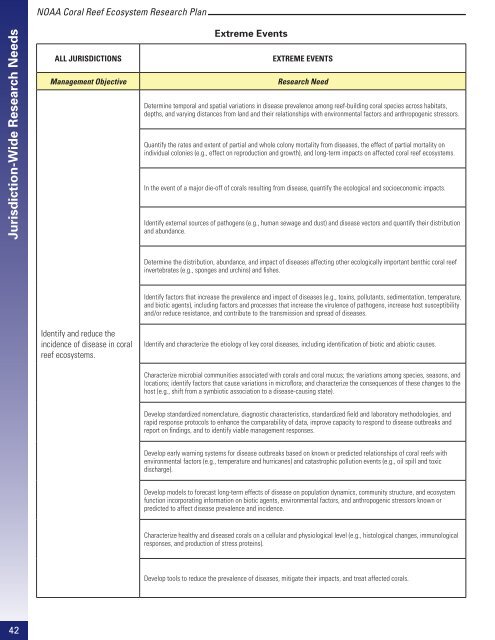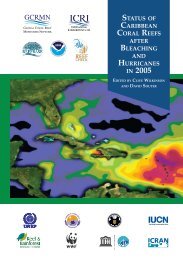noaa coral reef ecosystem research plan - Mississippi-Alabama Sea ...
noaa coral reef ecosystem research plan - Mississippi-Alabama Sea ...
noaa coral reef ecosystem research plan - Mississippi-Alabama Sea ...
Create successful ePaper yourself
Turn your PDF publications into a flip-book with our unique Google optimized e-Paper software.
NOAA Coral Reef Ecosystem Research Plan<br />
Jurisdiction-Wide Research Needs<br />
ALL JURISDICTIONS<br />
Management Objective<br />
Extreme Events<br />
EXTREME EVENTS<br />
Research Need<br />
Determine temporal and spatial variations in disease prevalence among <strong>reef</strong>-building <strong>coral</strong> species across habitats,<br />
depths, and varying distances from land and their relationships with environmental factors and anthropogenic stressors.<br />
Quantify the rates and extent of partial and whole colony mortality from diseases, the effect of partial mortality on<br />
individual colonies (e.g., effect on reproduction and growth), and long-term impacts on affected <strong>coral</strong> <strong>reef</strong> <strong>ecosystem</strong>s.<br />
In the event of a major die-off of <strong>coral</strong>s resulting from disease, quantify the ecological and socioeconomic impacts.<br />
Identify external sources of pathogens (e.g., human sewage and dust) and disease vectors and quantify their distribution<br />
and abundance.<br />
Determine the distribution, abundance, and impact of diseases affecting other ecologically important benthic <strong>coral</strong> <strong>reef</strong><br />
invertebrates (e.g., sponges and urchins) and fishes.<br />
Identify factors that increase the prevalence and impact of diseases (e.g., toxins, pollutants, sedimentation, temperature,<br />
and biotic agents), including factors and processes that increase the virulence of pathogens, increase host susceptibility<br />
and/or reduce resistance, and contribute to the transmission and spread of diseases.<br />
Identify and reduce the<br />
incidence of disease in <strong>coral</strong><br />
<strong>reef</strong> <strong>ecosystem</strong>s.<br />
Identify and characterize the etiology of key <strong>coral</strong> diseases, including identification of biotic and abiotic causes.<br />
Characterize microbial communities associated with <strong>coral</strong>s and <strong>coral</strong> mucus; the variations among species, seasons, and<br />
locations; identify factors that cause variations in microflora; and characterize the consequences of these changes to the<br />
host (e.g., shift from a symbiotic association to a disease-causing state).<br />
Develop standardized nomenclature, diagnostic characteristics, standardized field and laboratory methodologies, and<br />
rapid response protocols to enhance the comparability of data, improve capacity to respond to disease outbreaks and<br />
report on findings, and to identify viable management responses.<br />
Develop early warning systems for disease outbreaks based on known or predicted relationships of <strong>coral</strong> <strong>reef</strong>s with<br />
environmental factors (e.g., temperature and hurricanes) and catastrophic pollution events (e.g., oil spill and toxic<br />
discharge).<br />
Develop models to forecast long-term effects of disease on population dynamics, community structure, and <strong>ecosystem</strong><br />
function incorporating information on biotic agents, environmental factors, and anthropogenic stressors known or<br />
predicted to affect disease prevalence and incidence.<br />
Characterize healthy and diseased <strong>coral</strong>s on a cellular and physiological level (e.g., histological changes, immunological<br />
responses, and production of stress proteins).<br />
Develop tools to reduce the prevalence of diseases, mitigate their impacts, and treat affected <strong>coral</strong>s.<br />
42

















